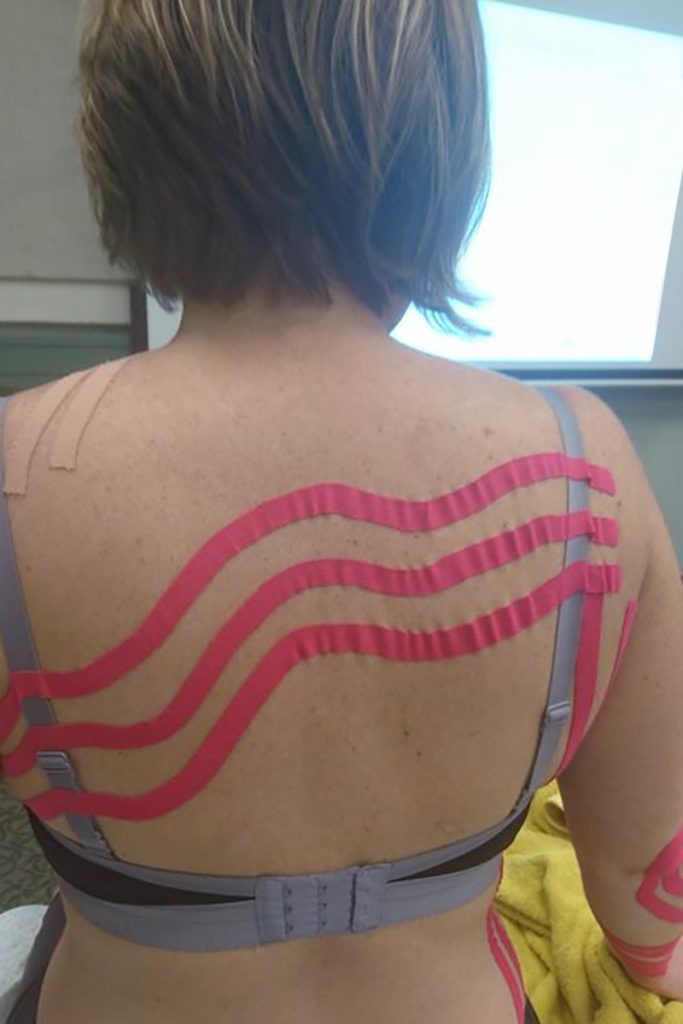
A growing technique in treating swelling symptoms of lymphedema is the use of kinesiology tape on patients. Kinesiology tape is a fabric tape with elastic embedded within, allowing it to be stretched when applied to the skin. It is used to treat various conditions and injuries. In addition, it can be used in pain management. Once applied, it allows full mobility whereas other rigid tapes do not. Kinesiotaping works by providing a negative pressure in the tissues by gently lifting the skin. As superficial tissues are pulled, more space is created within and between the tissue layers which allows lymphatic vessels to better draw fluid into them. Moving fluid from the tissues into the lymphatic vessels provides removal of toxins, debris, products of inflammation, bacteria, viruses etc. Other examples of negative pressure therapies are cupping, suction machines, diaphragmatic breathing, negative pressure wound healing devices and negative pressure massage.
Common conditions of lymphatic drainage with kinesiology tape

- Lymphedema – lymph taping for lymphedema can be applied to create compression or to encourage lymph flow in congested tissues. It provides a negative pressure in the tissues which encourages lymph flow. As you move the elastic fibers in the tape provide a stretching of the tissues similar to lymph drainage massage.
- Bruising – along with inflammation, dead cell debris is removed via the lymphatic system
- Muscle, ligament and tendon tears – the tape can provide support to an unstable joint and provide a healthy environment for healing by removing debris and inflammation. It is important to take into account that a reduction in pain is likely to occur in these conditions as the pain triggering chemicals are removed at a faster rate than normal. Therefore it is still advised to follow the normal timeframe of healing advised by a doctor or physio. These injuries have specific healing times and you would want to adhere to them.
- Arthritis – inflammation can be removed in a timely fashion to help reduce the pain sensations.
- Scars – kinesio tape can be applied to scars at a certain point in healing but not too early. Your massage therapist will be able to determine when depending on the stage of the wound healing. It may help reduce the adhesions of the scar which may allow better blood supply and lymph flow in the area of the damaged tissue.
- Post liposuction – after approximately two weeks post liposuction, the tissues in the area that were treated often become hardened (fibrotic) from a build up of proteins that were unable to enter into the damaged lymph vessels. Kinesio tape along with lymph drainage massage, compression and certain types of padding can help soften these tissues to assist in better drainage of the local area and promote healing.
Lymph taping is not suitable for
- open wounds, recent scars, deep vein thrombosis, allergy or sensitivity to adhesives. fragile or sensitive skin.
- moist or skin with lotion
- over body parts with hair as it will be painful to remove.
Application and Maintenance
Our lymphedema therapists at Flow are trained in the application of lymph taping. It is usually applied during a treatment involving the lymph drainage massage, but can be a stand alone therapy. Book an appointment with us to discuss.
Kinesiology tape is also water resistant allowing you to shower with it on. It can be left on the skin for several days and is best to leave on until it comes off easily, usually after one week. To keep the tape on longer, you can carefully trim away the end pieces that peel back and stray ends with bandage scissors. Kinesiology tape can be purchased from our clinic.
Denise Drisdelle is a registered massage therapist and co-founder of FLOW Lymphatic Health Services.